Chinese cuisine is as diverse as its culture, with a history that spans thousands of years and a geographic range that covers a vast and varied landscape. It is characterized not only by its rich historical background and regional varieties but also by its array of staple foods like rice and noodles. As much a feast for the eyes as for the palate, Chinese food combines an array of cooking techniques and flavors to create distinctive dishes that are enjoyed worldwide.
Flavors and seasonings such as soy sauce, ginger, garlic, and sesame oil are integral, providing the foundation for the intricate taste profiles unique to each regional cuisine. Additionally, the art of food presentation and dining etiquette play substantial roles in the overall experience of Chinese dining, reflecting the importance of respect and ritual in the culture. The culinary practice of sharing meals around a round table emphasizes the communal nature of dining, a testament to the cuisine's deep social significance.
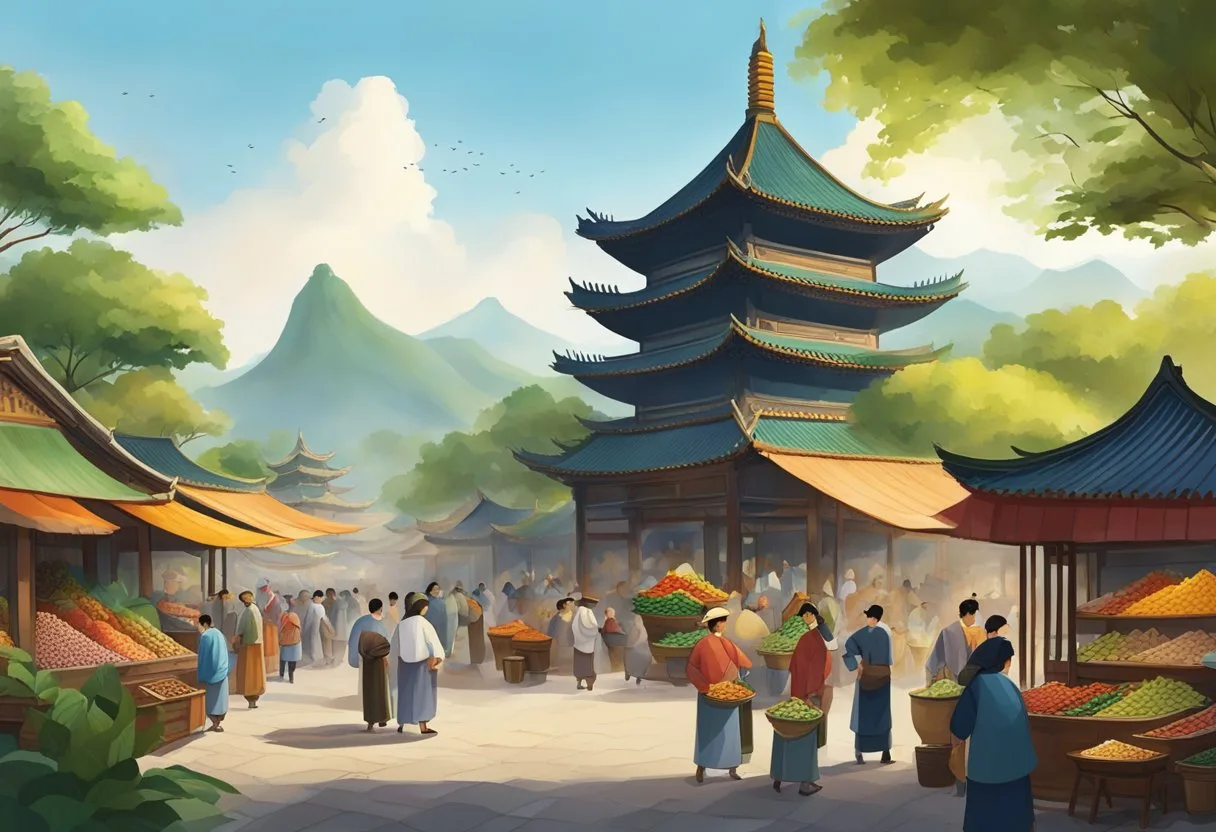
The historical tapestry of Chinese cuisine is rich and complex, woven from thousands of years of culinary development that mirrors the social and economic evolution of China itself.
Chinese cuisine has roots tracing back to the Shang Dynasty (approximately 1600–1046 BC), where the domestication of rice and millet formed the cornerstone of early Chinese diets. According to archaeological findings, the oldest noodle discovered suggests a 4,000-year-old history of noodle consumption in China. It was during the Han Dynasty (206 BC–220 AD) when the influence of trade introduced new foodstuffs such as sesame, peas, and coriander from the West.
Imperial cuisine represented the pinnacle of culinary sophistication in ancient China. Emperors of successive dynasties hosted grand banquets that showcased a vast range of regional delicacies and intricate cooking techniques. The earliest known Chinese cookbook, believed to date back to the Han Dynasty, indicates a well-established gastronomic culture that was to influence imperial menus and courtly dining rituals.
The vast geography of China gave rise to a diverse array of regional cuisines. Each region developed its unique style of cooking, ingredients, and flavors. As stated in history of Chinese cuisine, significant regional cuisines include Cantonese, Sichuan, Anhui, Shandong, Fujian, Jiangsu, Hunan, and Zhejiang. These styles evolved under the influence of local climate, geography, history, and lifestyle, creating a rich mosaic that is recognized as one of the world’s major culinary traditions.
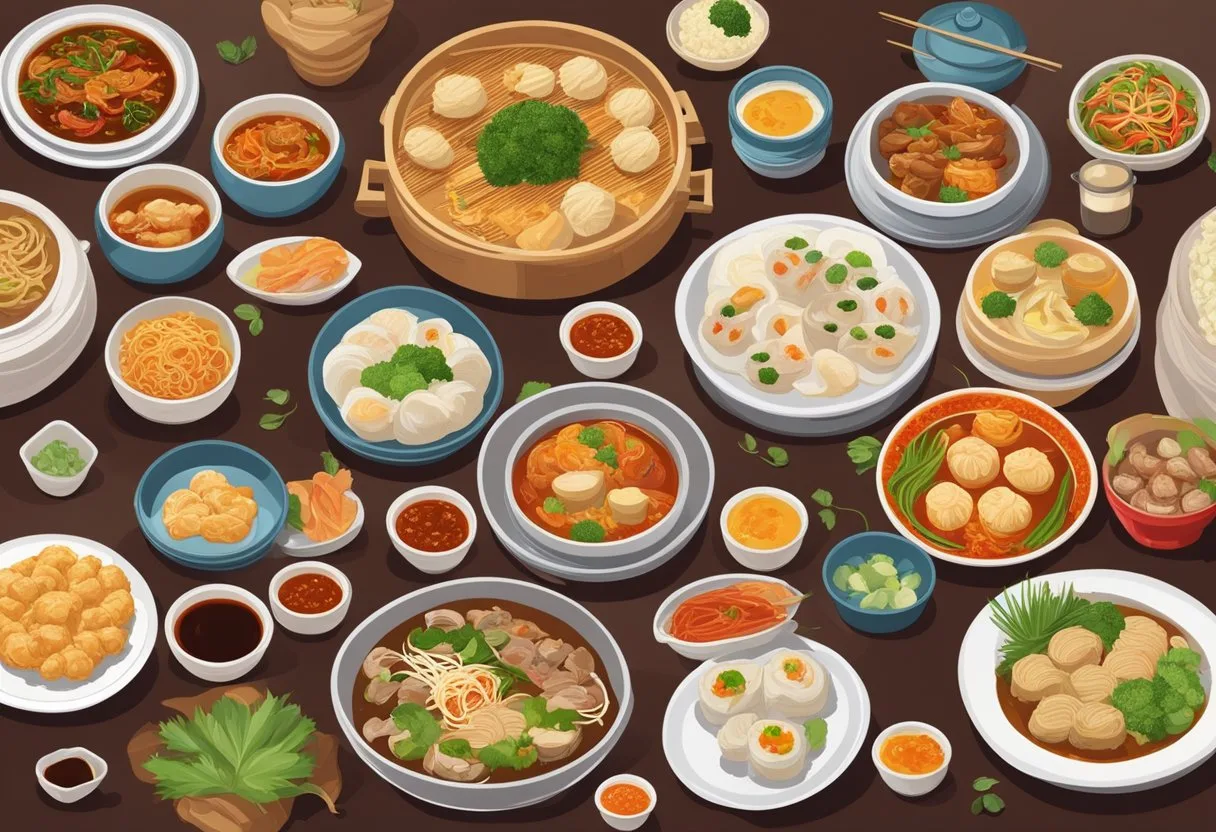
Chinese cuisine is as diverse as its geography and climate, with each region imparting a unique flavor profile to its dishes. Here, the culinary art is not just about taste but also the reflection of cultural and historical influences.
Sichuan Cuisine is renowned for its bold and pungent flavors, characterized by the use of garlic and chili peppers. Mala, a numbing spiciness from Sichuan peppercorns, is a distinctive feature of dishes such as mapo tofu and kung pao chicken. More on Sichuan Cuisine
Cantonese Cuisine prioritizes fresh ingredients and subtle seasoning, with a focus on steamed and stir-fried dishes. It includes a wide variety of soups and the famous dim sum, delivering flavors that are often mild and balanced. Explore Cantonese dishes
Hunan Cuisine is noted for its hot spicy flavors, fresh aroma, and deep color. Ingredients used are often smoked and pickled, and dishes like spicy beef stir-fry showcase the region's affinity for chili peppers.
Jiangsu Cuisine emphasizes seafood and soups, with a taste that’s often sweet and light. Presentation is key, with an elegant and delicate appearance, and dishes such as salted duck and sweet and sour mandarin fish are celebrated examples.
Zhejiang Cuisine is distinguished by its mellow flavors that focus on bringing out the taste of the main ingredient. It often features bamboo shoots and is known for its dishes like West Lake fish in vinegar sauce.
Fujian Cuisine offers a slightly sweet and sour taste, with a notable use of broths and soups. Unique ingredients like edible mushrooms and bamboo, combined with techniques like braising and stewing, produce its distinct flavor.
Shandong Cuisine, one of the oldest in China, is known for its emphasis on fresh ingredients, especially seafood, with a taste that tends to be salty and crispy. Dishes such as braised abalone and sweet and sour carp are staples of the cuisine.
Anhui Cuisine uses a variety of herbs and plants, often sourced from the region's mountainous areas. It is known for its use of wild game and ingredients like bamboo, resulting in a deeply flavored and aromatic cuisine.
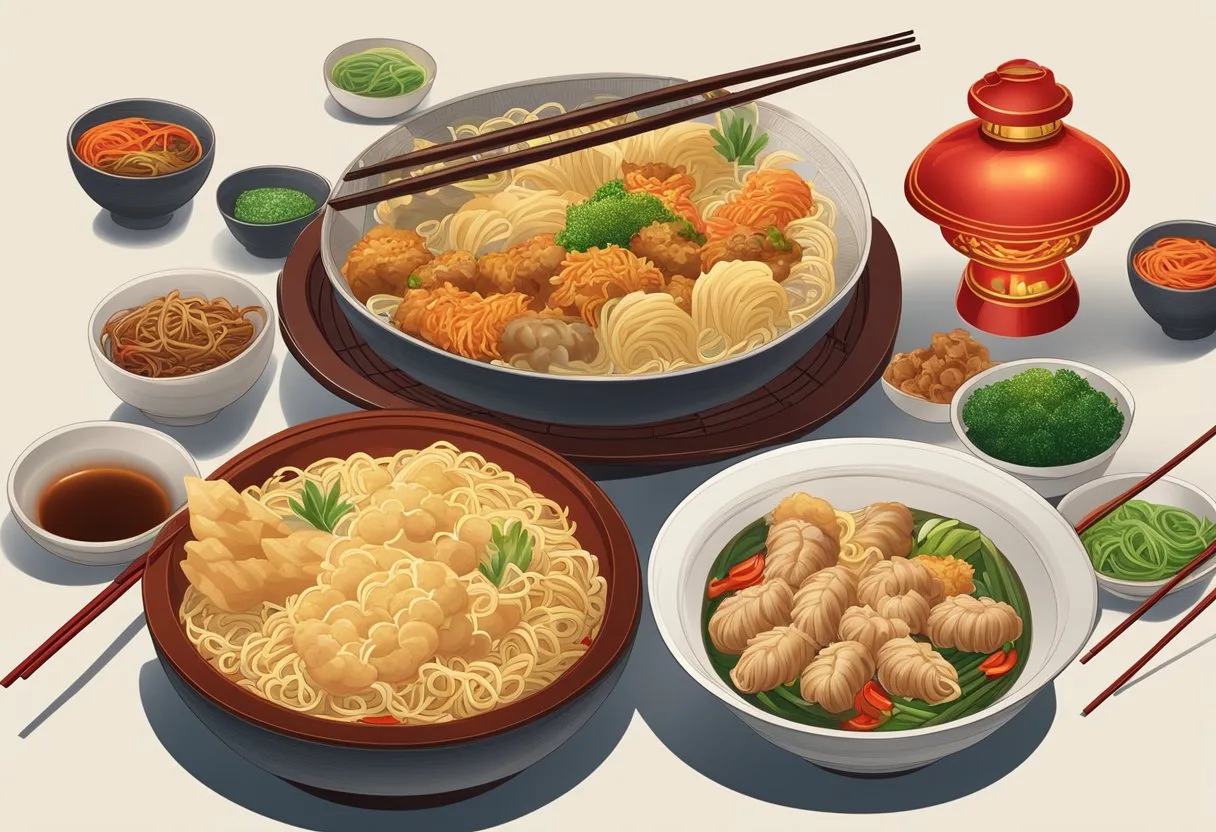
Chinese cuisine features a variety of staple foods that are essential to daily meals across the different regions of China. These staples—comprising chiefly of rice, noodles, and various breads and buns—are integral not just for sustenance but also for the cultural richness they bring to the dining table.
In China, rice serves as the backbone of many meals, particularly in the southern parts of the country where it is grown extensively. An example is Yangzhou fried rice, a dish that embodies the versatility and importance of rice in Chinese cooking. From plain steamed varieties used as accompaniments to richly flavored dishes to being the main ingredient in fried rice, rice’s prominence in Chinese cuisine is undisputable.
Noodles come in a close second, popular for their variety in texture and form. Used in a myriad of dishes from soups to stir-fries, noodles are loved for their adaptability. They can be made from different types of flour like wheat or rice and can be served in many different styles, as reflected in dishes like Chow Mein and hand-pulled noodles.
Lastly, the diversity of Chinese breads and buns might surprise those unfamiliar with the intricacies of the cuisine. Steamed buns such as bāozi and fried breads like yóutiáo are pervasive in breakfast menus and street food stalls alike. They are not just mere sides but embody significant cultural and historical symbolism in the realm of Chinese gastronomy.
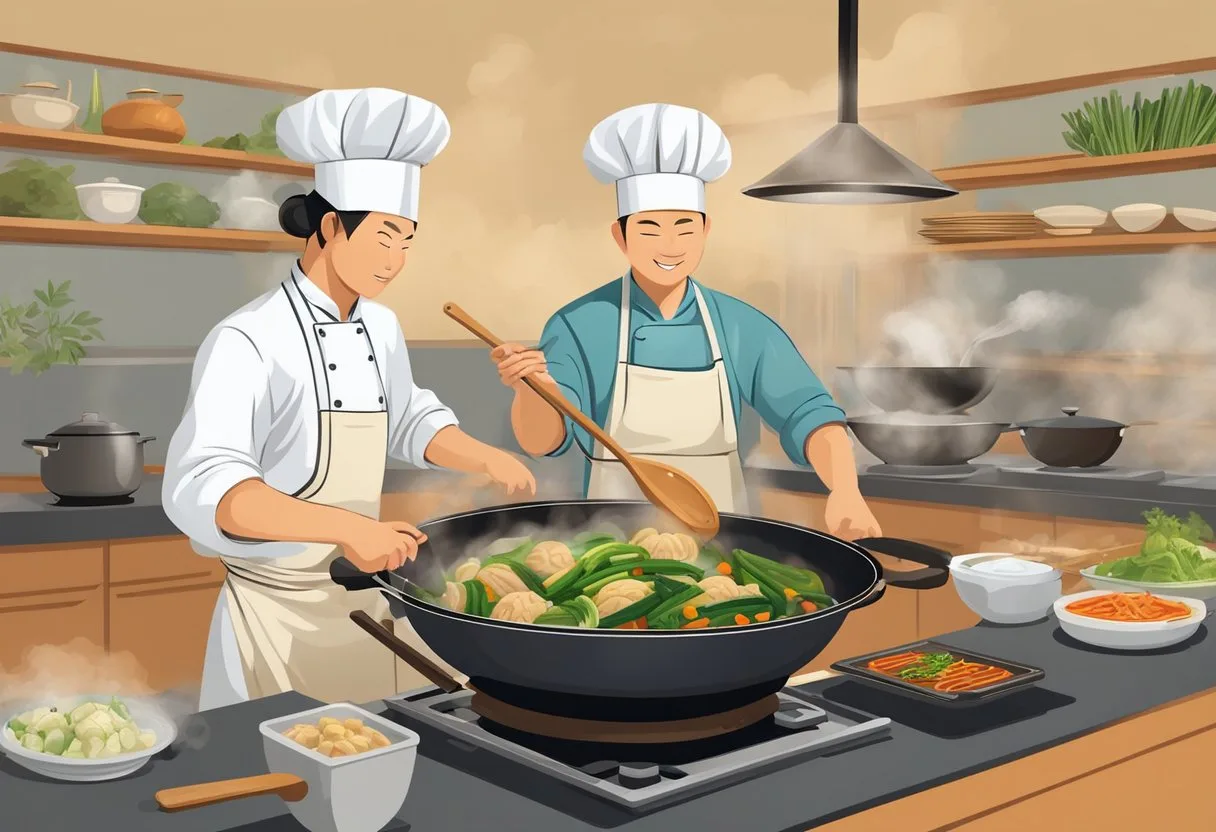
Chinese cuisine employs a variety of intricate techniques that have been refined over centuries. These techniques are essential for creating the distinct flavors and textures that characterize Chinese dishes.
Stir frying is an essential technique in Chinese cooking, involving high heat and continuous movement. She uses a minimal amount of oil in a wok, rapidly cooking ingredients such as black pepper beef fillet while tossing them swiftly to ensure even cooking and preservation of flavor and nutrients.
This gentle cooking method retains the natural qualities of ingredients. They often utilize bamboo steamer baskets to steam items like fish or buns, ensuring that dishes like juicy pork dumplings are cooked through without losing their texture or taste.
Roasting in Chinese cuisine typically involves long cooking times and lower heat compared to Western methods. Peking duck is a famous dish prepared using the roasting technique, where they ensure the skin is crispy and the meat succulent.
Boiling is a fundamental method, used not just for soups, but also for blanching and preparing various types of produce. They meticulously control the temperature and timing to achieve a tender yet firm texture in vegetables and meats.
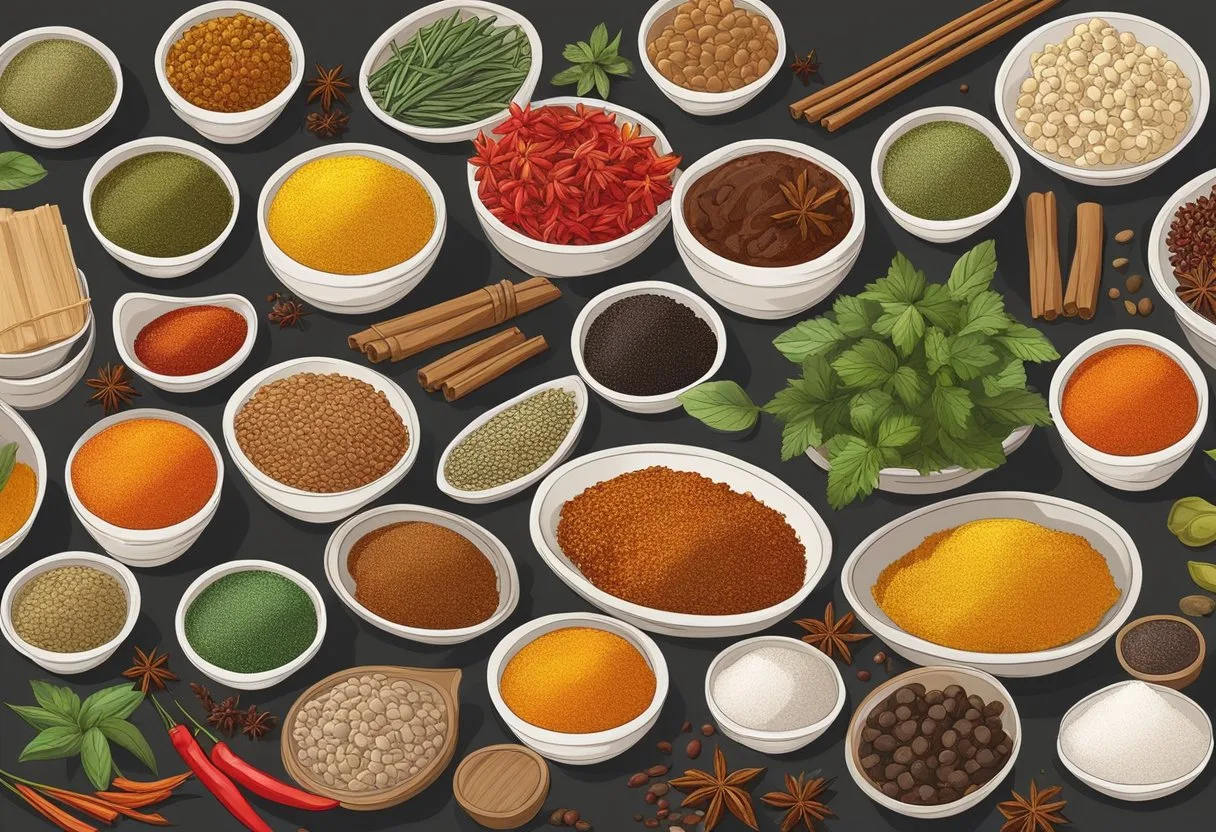
Chinese cuisine is renowned for its rich palette of flavors and seasonings, each contributing to the distinctive taste of regional dishes. From the unique blend of the Five Spices to the umami depth of Soy Sauce, these ingredients are essential in crafting authentic Chinese flavors.
The Five Spice Powder is a foundation of Chinese flavor profiles, typically consisting of cinnamon, cloves, fennel, star anise, and Sichuan peppercorns. Each spice offers a unique taste sensation, from sweet to savory, that melds to create a complex and harmonious flavor used to season meats, stews, and marinades.
Soy Sauce holds a dual role as a seasoning and a condiment in Chinese cooking. There are primarily two types: light soy sauce, which is more salty and thinner, used for seasoning during cooking, and dark soy sauce, which has a richer flavor and is often used in braises and marinades.
A rich and thick Oyster Sauce provides a savory and slightly sweet flavor to Chinese dishes. Made from oyster extracts, this sauce is a staple for enhancing stir-fries, vegetable dishes, and meats with a glossy, caramelized coating.
Bean Paste, including varieties like Doubanjiang (spicy bean paste), is an essential ingredient especially in Sichuan cuisine. It imparts a salty and slightly spicy depth to dishes, often serving as the base seasoning for many sauces and braises.
The use of Chili Peppers varies across regional Chinese cuisines, providing a range from mild to explosive heat. In addition to whole dried peppers, chili flakes and powders are also incorporated into spice mixes and oils to introduce a spicy kick to countless Chinese recipes.
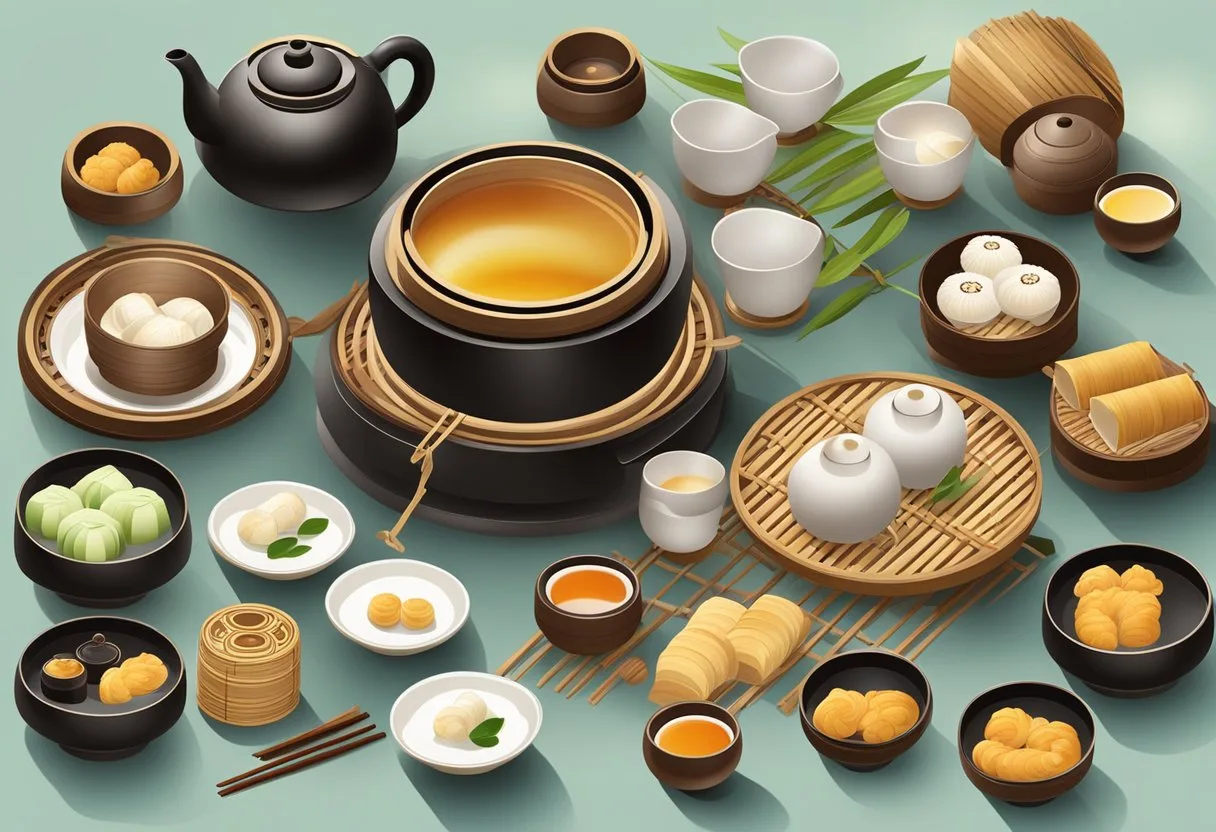
In the heart of Chinese culinary traditions lies the practice of Yum Cha, which integrates the enjoyment of dim sum with the serenity of tea drinking. This harmonious pairing has evolved into a cherished ritual, often referred to as a brunch meal. Those who partake in Yum Cha experience a variety of small dishes alongside their tea, each dish showcasing a facet of regional flavors and craft.
Typical dim sum offerings include:
The tea culture integral to this experience is meticulous, involving careful selection and preparation. Tea varieties commonly enjoyed include:
As the meal unfolds, they pour tea with deliberation, respecting traditions that date back to ancient tea houses along the Silk Road. Dim sum dishes are often chosen to complement the selected tea, creating a balance of flavors.
The setting for Yum Cha is equally important, where the ambiance of the tea house contributes to the sensory journey. While the origins of dim sum are rooted in providing sustenance for weary travelers, modern-day tea houses focus on fostering connections over shared plates, a nod to the communal essence of this age-old tradition. In today's dim sum experience, the artistry of the meal lies not just in the array of dishes but also in the communal tapestry it weaves amongst those gathered at the table.
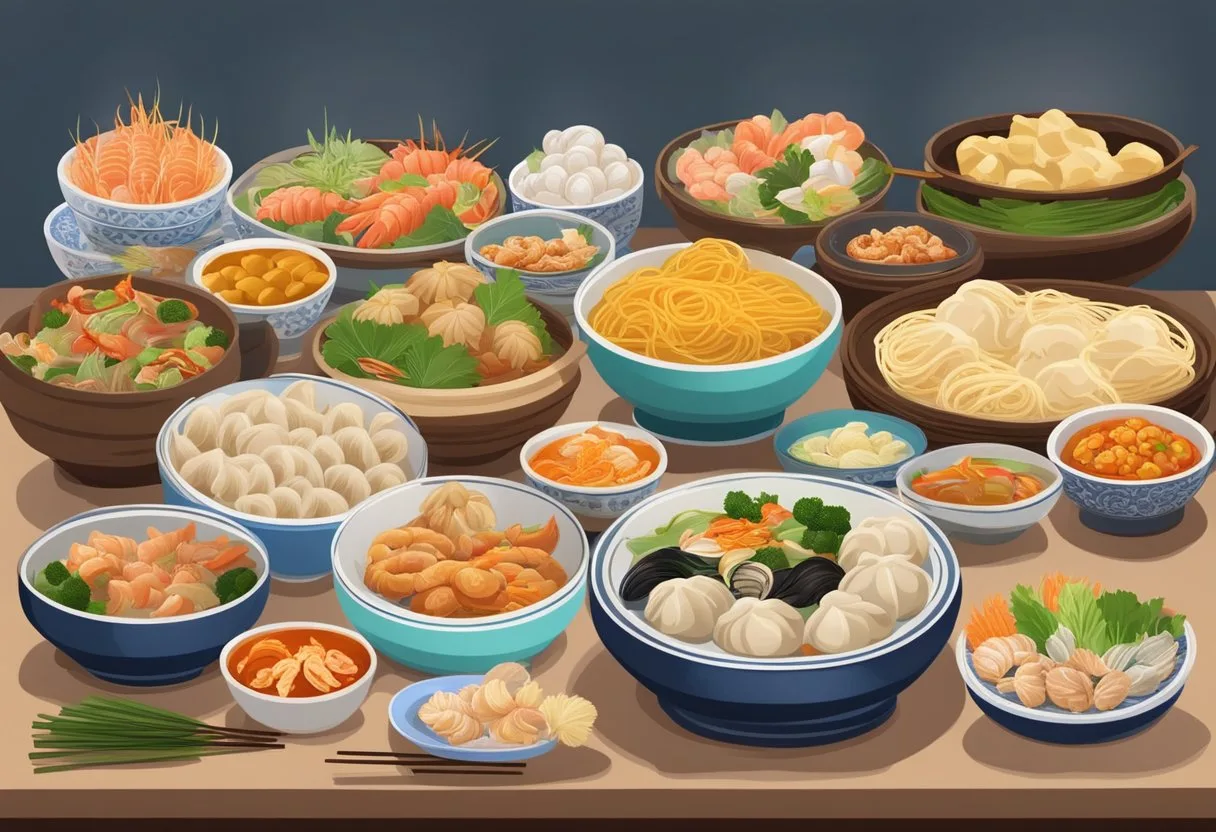
Chinese cuisine is closely intertwined with its festivals and celebrations, featuring foods that carry symbolic meanings and are integral to the cultural rituals observed throughout the year.
The most important festivity in the Chinese calendar, the Lunar New Year, is marked by the preparation of various traditional dishes. Prominent among them are dumplings (jiaozi), symbolizing wealth due to their resemblance to ancient Chinese money. Another notable dish is the Eight Treasures Rice (ba bao fan), a sweet and sticky dessert conveying prosperity and good fortune.
During the Mid-Autumn Festival, the consumption of mooncakes is essential. These round pastries, typically filled with lotus seed paste and salted egg yolk, mirror the full moon and embody reunion and completeness. Families often gather to share mooncakes while admiring the moon as a gesture of togetherness and harmony.
To commemorate the Dragon Boat Festival, zongzi—glutinous rice dumplings wrapped in bamboo leaves—are a staple. These dumplings are commonly filled with a variety of ingredients, ranging from savory meats to sweet red bean paste, and their triangular shape is thought to ward off evil spirits. The festival is a homage to the patriotic poet Qu Yuan, and the consumption of zongzi is a tribute to the legend of his life and death.

Chinese cuisine has significantly impacted dining habits and culinary traditions around the globe, particularly through the establishment of Chinatowns and through the adaptation and fusion of traditional dishes with local flavors.
Chinatowns serve as cultural epicenters where Chinese food has thrived internationally. Major cities like San Francisco, London, and Sydney are renowned for their vibrant Chinatowns, offering an array of authentic Chinese dishes. Not only do these neighborhoods provide a taste of home for Chinese immigrants, but they also introduce local populations to the diverse culinary styles of China, including Szechuan, Cantonese, and Hunan cuisines.
Chinese food has shown a remarkable ability to adapt to local tastes while still maintaining its core identity. In the United States, dishes like General Tso’s Chicken have become staples, although they are tailored to suit the American palate. Similarly, Chinese cuisine has incorporated regional ingredients and techniques, leading to innovative fusion dishes such as Sino-Mediterranean or Sino-French hybrid creations, which further showcases the cuisine's adaptability and worldwide appeal.
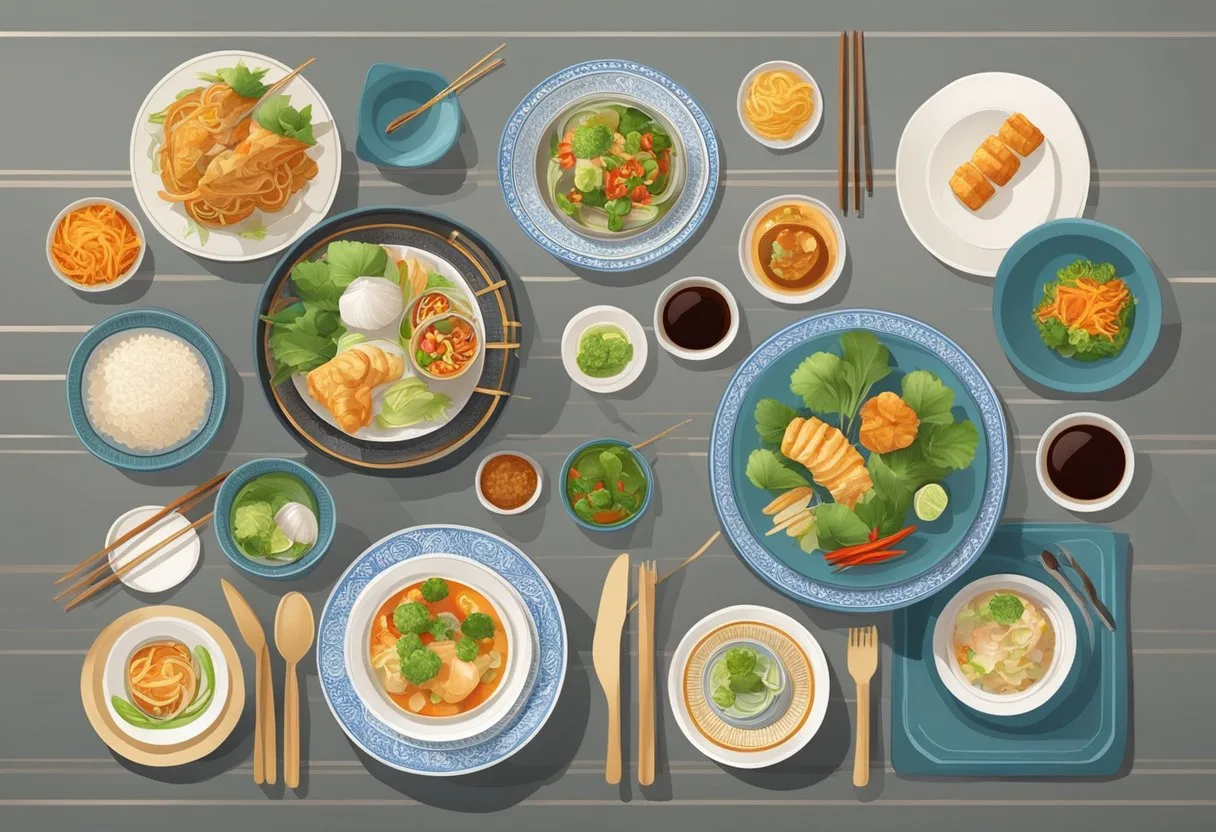
In Chinese dining traditions, the presentation of food is as vital as the taste and flavor. Chefs often utilize ingredients with multiple colors to create a visually attractive dish, reflecting the importance of harmony and balance.
Etiquette is deeply embedded in the dining experience and adheres to certain standards and practices. A typical table setting includes a round table, enhancing the sense of community, as dining is considered a collective activity rather than an individualistic one. Significant principles include:
| Do's | Don'ts |
|---|---|
| Offer dishes to others first | Tap the bowl with chopsticks |
| Compliment the host's choice of dishes | Waste food |
| Try a bit of everything | Flip fish over |
The practice of 'ganbei' or 'dry cup', similar to the Western 'cheers', is also an integral part of toasting during a meal. Participants are expected to finish their drink as a sign of respect and camaraderie.
For more nuanced insights into these traditions, further reading is available on the cultural significance of Chinese dining traditions. This guide covers table manners and dining habits important for ensuring a polite and enjoyable meal in a Chinese setting.

The dynamics of Chinese cuisine are embracing sustainability with modern interpretations. These trends are evident within the organic movement and the rise of plant-based alternatives, reflecting both environmental concern and changing consumer preferences.
The organic movement in China is gaining traction as consumers become more health-conscious and environmentally aware. Upscale restaurants are leading the way, much like Hakkasan, a restaurant with a multi-million-pound interior that places high value on sustainably sourced ingredients. The popularity of organic produce is indicative of a broader shift towards more ethical eating habits and responsible sourcing within the culinary scene.
China's dietary patterns are undergoing a transformation, with a significant increase in the consumption of plant-based foods. This change is driven by a recognition of the environmental impacts of traditional meat-heavy diets and a growing demand for sustainable and nutritious food options. New culinary innovations are arising, offering plant-based versions of traditional dishes, aiming to reduce environmental burdens and cater to the palates of both local and global diners.
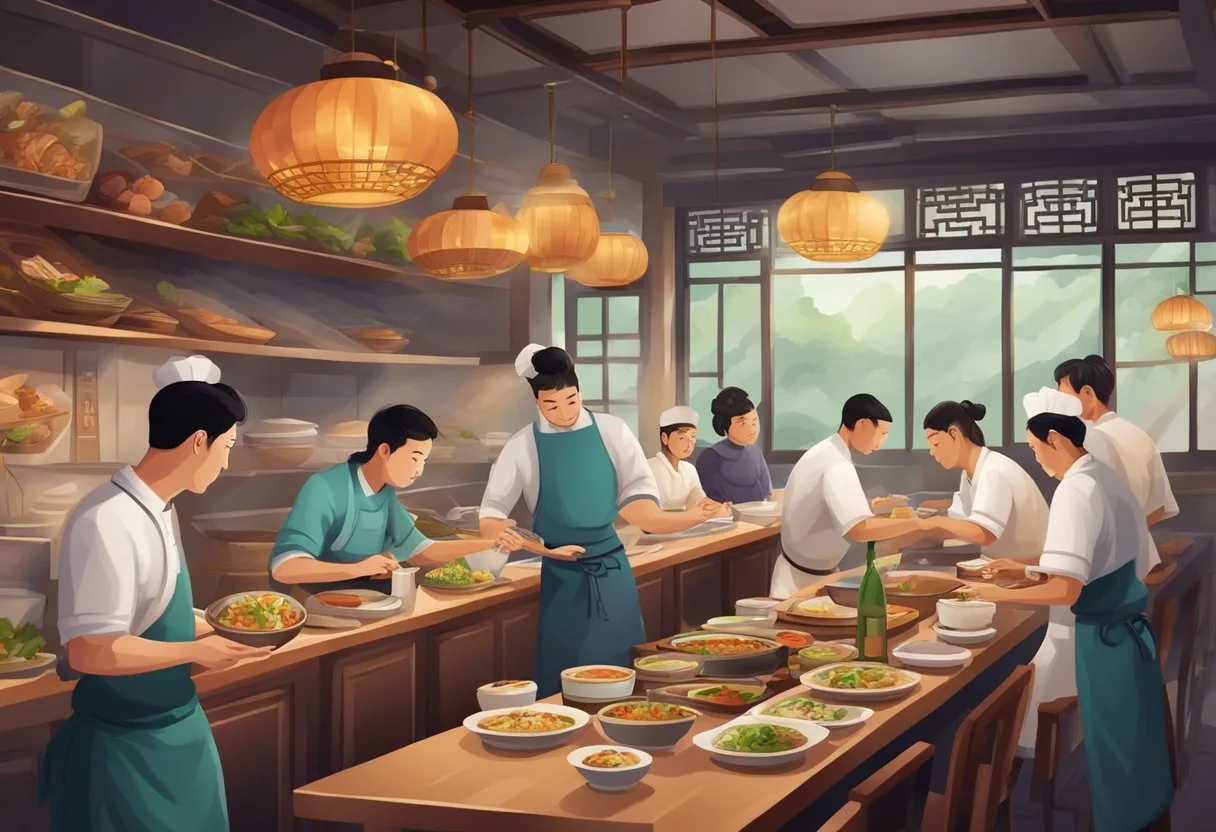
This section addresses some of the most common queries related to the rich and diverse world of Chinese cuisine, providing insights into traditional dishes, regional influences, and culinary customs.
Signature dishes of traditional Chinese cuisine often include dumplings and noodle soups, which vary from region to region. These staples, along with Peking duck and char siu (barbecued pork), are deeply rooted in China's culinary tradition.
The five major cuisines, known as the "Five Great Cuisines," are shaped by the regions of Shandong, Sichuan, Guangdong (Cantonese), Hunan, and Jiangsu. Each region has contributed significantly to the flavors and techniques that define traditional Chinese cooking.
Authentic Chinese traditional foods with historical significance include century eggs, which have been preserved using traditional methods, and zongzi (rice dumplings), which are traditionally eaten during the Dragon Boat Festival.
Chinese food culture places a strong emphasis on balance, both in flavors and nutrition, with a focus on fresh ingredients and varied cooking methods. In contrast, Western cuisines often center on heavier dishes with a prominent use of dairy and bread.
One must try dishes like mapo tofu, which showcases the mouth-numbing Sichuan peppercorn, and xiaolongbao, delicate soup dumplings from Shanghai. These dishes offer a glimpse into the complexity of flavors found across China's culinary landscape.
In Los Angeles, famous Chinese restaurants include Sea Harbour and Din Tai Fung, recognized for their authentic flavors and meticulous preparation of traditional Chinese dishes. These dining spots provide a genuine taste of China's gastronomic heritage.
